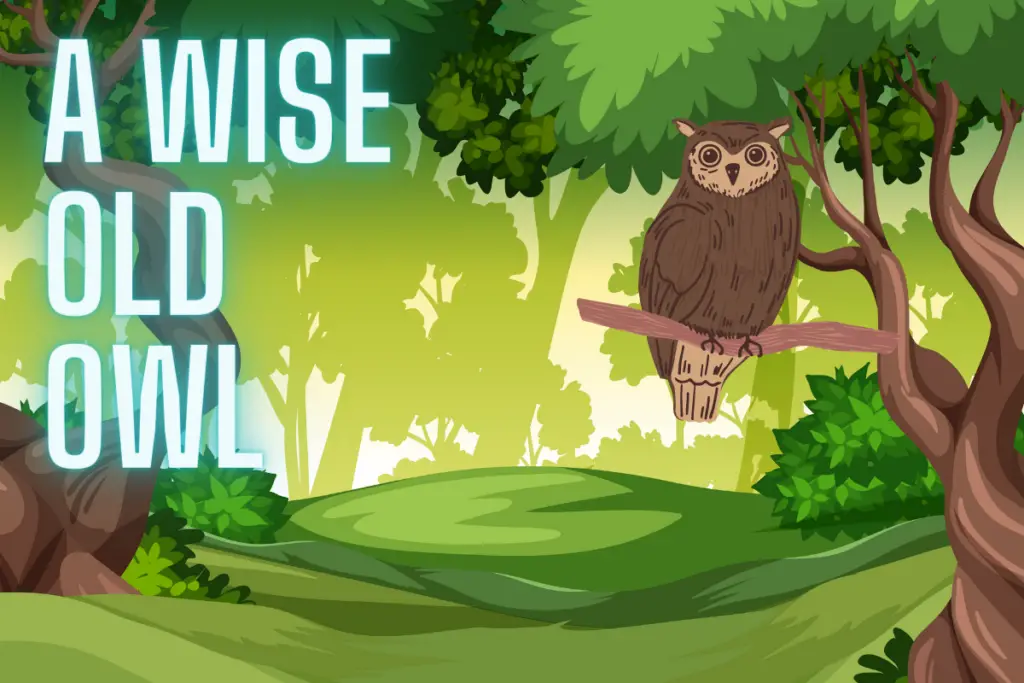The seemingly simple nursery rhyme, “A Wise Old Owl,” with its repetitive structure and avian protagonist, has resonated with generations. Its brevity belies a subtle depth, hinting at profound life lessons applicable far beyond the confines of childhood.
I. The Allure of Avian Wisdom: Why an Owl?
A. Nocturnal Habits and Observational Prowess. Owls are creatures of the night. This nocturnal existence lends itself to the perception of enhanced observation. They watch the world when others sleep, a silent, feathered sentinel absorbing unseen truths. Their large, forward-facing eyes, unusual in the avian world, reinforce this impression of focused attention.
B. Cultural Symbolism: Intelligence and Insight. Across cultures, owls are frequently associated with wisdom and knowledge. In Greek mythology, the owl was the symbol of Athena, the goddess of wisdom. This historical precedent has solidified the owl’s place in the collective consciousness as a creature of intellect.
C. The Silent Hunter: A Metaphor for Reflective Thought. The owl’s hunting style, characterized by silent flight and patient observation, mirrors the process of careful consideration and reflective thought. Just as an owl surveys its surroundings before striking, so too should individuals deliberate before acting.
II. Observing More, Speaking Less: The Virtue of Restraint
A. The Rhyme’s Central Tenet: “The less he spoke, the more he heard.” This pivotal line encapsulates the core message of the rhyme. It posits a direct correlation between listening and learning. It implicitly values receptive attentiveness over garrulous pronouncements.
B. Cultivating Active Listening: Beyond Passive Hearing. True listening transcends mere auditory perception. It involves actively engaging with the speaker, attempting to comprehend their perspective, and withholding judgment. It demands a conscious effort to quiet internal dialogues and focus on the external message.
C. The Perils of Premature Articulation: Guarding Against Misinformation. Speaking without sufficient information can lead to the dissemination of inaccuracies and the perpetuation of misunderstandings. Exercising verbal restraint allows time for contemplation and verification, mitigating the risk of unintended consequences.
III. The Power of Silence: Embracing Introspection
A. Silence as a Conduit for Internal Reflection. In a world saturated with constant noise and distractions, silence provides a crucial opportunity for introspection. It allows individuals to connect with their inner thoughts, feelings, and intuitions.
B. Mindfulness and the Art of Present Moment Awareness. Practicing silence can facilitate mindfulness, a state of heightened awareness of the present moment. This heightened awareness can enhance focus, reduce stress, and improve overall well-being.
C. Combating the Urge to Interrupt: Fostering Respectful Dialogue. Resisting the impulse to interrupt others during conversations is a cornerstone of respectful communication. It demonstrates a genuine interest in their perspectives and fosters a more collaborative exchange of ideas.
IV. Learning Through Observation: The World as a Classroom
A. Beyond Formal Education: Unstructured Learning Environments. While formal education is valuable, significant learning occurs outside of traditional classroom settings. Observing the world around us – the interactions between people, the patterns of nature, the consequences of actions – provides a rich source of knowledge.
B. Emulating the Owl’s Vigilance: Paying Attention to Detail. The wise old owl observes the nuances of its environment. Similarly, individuals can enhance their understanding by paying close attention to the details of their surroundings. This attentiveness allows for the identification of subtle patterns and the anticipation of potential outcomes.
C. Developing Critical Thinking Skills: Analyzing Observed Phenomena. Observation alone is insufficient. It must be coupled with critical thinking skills – the ability to analyze observed phenomena, identify underlying causes, and draw logical conclusions. This analytical process transforms passive observation into active learning.
V. The Enduring Relevance of Simple Wisdom
A. Navigating the Complexities of Modern Life. In an era characterized by information overload and constant connectivity, the simple wisdom of “A Wise Old Owl” is more relevant than ever. Its emphasis on listening, observing, and reflecting provides a valuable counterbalance to the relentless demands of the modern world.
B. Cultivating Empathy and Understanding. By prioritizing listening over speaking, individuals can cultivate empathy and understanding. This heightened awareness of others’ perspectives fosters stronger relationships and more effective communication.
C. A Timeless Lesson for All Ages. While ostensibly a children’s rhyme, the message of “A Wise Old Owl” transcends age. It serves as a constant reminder of the importance of mindful communication, reflective thought, and the enduring power of observation. The seemingly simple ditty imparts a profound and perpetually pertinent truth: judicious listening and astute observation are the cornerstones of sagacity. This deceptively straightforward verse offers invaluable guidance for navigating the multifaceted tapestry of existence.
